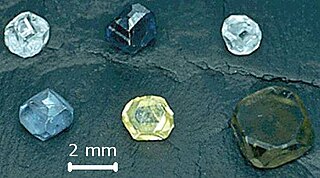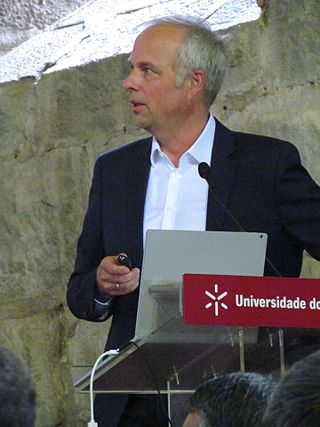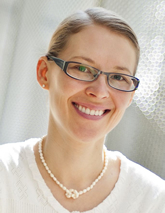Microphotonics is a branch of technology that deals with directing light on a microscopic scale and is used in optical networking. Particularly, it refers to the branch of technology that deals with wafer-level integrated devices and systems that emit, transmit, detect, and process light along with other forms of radiant energy with photon as the quantum unit.

Photonics is a branch of optics that involves the application of generation, detection, and manipulation of light in the form of photons through emission, transmission, modulation, signal processing, switching, amplification, and sensing.

A photonic crystal is an optical nanostructure in which the refractive index changes periodically. This affects the propagation of light in the same way that the structure of natural crystals gives rise to X-ray diffraction and that the atomic lattices of semiconductors affect their conductivity of electrons. Photonic crystals occur in nature in the form of structural coloration and animal reflectors, and, as artificially produced, promise to be useful in a range of applications.

A blue laser emits electromagnetic radiation with a wavelength between 400 and 500 nanometers, which the human eye sees in the visible spectrum as blue or violet.

Imperfections in the crystal lattice of diamond are common. Such defects may be the result of lattice irregularities or extrinsic substitutional or interstitial impurities, introduced during or after the diamond growth. The defects affect the material properties of diamond and determine to which type a diamond is assigned; the most dramatic effects are on the diamond color and electrical conductivity, as explained by the electronic band structure.
Nanophotonics or nano-optics is the study of the behavior of light on the nanometer scale, and of the interaction of nanometer-scale objects with light. It is a branch of optics, optical engineering, electrical engineering, and nanotechnology. It often involves dielectric structures such as nanoantennas, or metallic components, which can transport and focus light via surface plasmon polaritons.

The nitrogen-vacancy center is one of numerous photoluminescent point defects in diamond. Its most explored and useful properties include its spin-dependent photoluminescence, and its relatively long (millisecond) spin coherence at room temperature, lasting up to milliseconds. The NV center energy levels are modified by magnetic fields, electric fields, temperature, and strain, which allow it to serve as a sensor of a variety of physical phenomena. Its atomic size and spin properties can form the basis for useful quantum sensors.

Jörg Wrachtrup is a German physicist. He is director of the 3rd Institute of Physics and the Centre for Applied Quantum Technology at Stuttgart University. He is an appointed Max Planck Fellow at the Max Planck Institute for Solid State Research in Stuttgart. Wrachtrup is a pioneer in solid state quantum physics. Already in his PhD thesis, he carried out the first electron spin resonance experiments on single electron spins. The work was done in close collaboration with M. Orrit at the CNRS Bordeaux. To achieve the required sensitivity and selectivity, optical excitation of single molecules was combined with spin resonance techniques. This optically detected magnetic resonance is based on spin dependent optical selection rules. An important part of the early work was coherent control. As a result the first coherent experiments on single electron spins and nuclear spins in solids were accomplished.

Vladimir (Vlad) M. Shalaev is a Distinguished Professor of Electrical and Computer Engineering and Scientific Director for Nanophotonics at Birck Nanotechnology Center, Purdue University.
A single-photon source is a light source that emits light as single particles or photons. Single-photon sources are distinct from coherent light sources (lasers) and thermal light sources such as incandescent light bulbs. The Heisenberg uncertainty principle dictates that a state with an exact number of photons of a single frequency cannot be created. However, Fock states can be studied for a system where the electric field amplitude is distributed over a narrow bandwidth. In this context, a single-photon source gives rise to an effectively one-photon number state.
A nanophotonic resonator or nanocavity is an optical cavity which is on the order of tens to hundreds of nanometers in size. Optical cavities are a major component of all lasers, they are responsible for providing amplification of a light source via positive feedback, a process known as amplified spontaneous emission or ASE. Nanophotonic resonators offer inherently higher light energy confinement than ordinary cavities, which means stronger light-material interactions, and therefore lower lasing threshold provided the quality factor of the resonator is high. Nanophotonic resonators can be made with photonic crystals, silicon, diamond, or metals such as gold.

The silicon-vacancy center (Si-V) is an optically active defect in diamond (referred to as a color center) that is receiving an increasing amount of interest in the diamond research community. This interest is driven primarily by the coherent optical properties of the Si-V, especially compared to the well-known and extensively-studied nitrogen-vacancy center (N-V). While the negative Si-V− center has received the majority of the silicon-vacancy center research, interest is growing in the neutral Si-V0 center as well.

Nikolay Zheludev is a British scientist specializing in nanophotonics, metamaterials, nanotechnology, electrodynamics, and nonlinear optics. Nikolay Zheludev is one of the founding members of the closely interlinked fields of metamaterials and nanophotonics that emerged at the dawn of the 21st century on the crossroads of optics and nanotechnology. Nikolay's work focus on developing new concepts in which nanoscale structuring of matter enhance and radically change its optical properties.
A quantum dot single-photon source is based on a single quantum dot placed in an optical cavity. It is an on-demand single-photon source. A laser pulse can excite a pair of carriers known as an exciton in the quantum dot. The decay of a single exciton due to spontaneous emission leads to the emission of a single photon. Due to interactions between excitons, the emission when the quantum dot contains a single exciton is energetically distinct from that when the quantum dot contains more than one exciton. Therefore, a single exciton can be deterministically created by a laser pulse and the quantum dot becomes a nonclassical light source that emits photons one by one and thus shows photon antibunching. The emission of single photons can be proven by measuring the second order intensity correlation function. The spontaneous emission rate of the emitted photons can be enhanced by integrating the quantum dot in an optical cavity. Additionally, the cavity leads to emission in a well-defined optical mode increasing the efficiency of the photon source.

Alexandra Boltasseva is Ron And Dotty Garvin Tonjes Distinguished Professor of electrical and computer engineering at Purdue University, and editor-in-chief for The Optical Society's Optical Materials Express journal. Her research focuses on plasmonic metamaterials, manmade composites of metals that use surface plasmons to achieve optical properties not seen in nature.
In quantum computing, quantum memory is the quantum-mechanical version of ordinary computer memory. Whereas ordinary memory stores information as binary states, quantum memory stores a quantum state for later retrieval. These states hold useful computational information known as qubits. Unlike the classical memory of everyday computers, the states stored in quantum memory can be in a quantum superposition, giving much more practical flexibility in quantum algorithms than classical information storage.

Jingyu Lin is a Chinese-American physicist and engineer working in the field of wide bandgap semiconductors and photonic devices. She is a co-inventor of MicroLED. In 2000, the husband-wife research team led by Hongxing Jiang and Jingyu Lin at Kansas State University (KSU) proposed and realized the operation of the first MicroLED and passive driving MicroLED microdisplay. In 2009, their team and colleagues at III-N Technology, Inc. and Texas Tech University (TTU) realized and patented the first active driving MicroLED microdisplay in VGA format by heterogeneously integrating MicroLED array with Si CMOS active-matrix driver.

Maiken Mikkelsen is a physicist who won the Maria Goeppert Mayer award from the American Physical Society in 2017 for her work in quantum nanophotonics. She is currently the James N. and Elizabeth H. Barton Associate Professor of Electrical and Computer Engineering and an associate professor of physics at Duke University where she teaches ECE 891: internship and ECE 524: introduction to solid state physics. Mikkelsen is credited for many advancements in optoelectronics, nanophotonics, human health and the environment.

Silicon carbide color centers are point defects in the crystal lattice of silicon carbide, which are known as color centers. These color centers have multiple uses, some of which are in photonics, semiconductors, and quantum applications like metrology and quantum communication. Defects in materials have a plethora of applications, but the reason defects, or color centers in silicon carbide are significant is due to many important properties of these color centers. Silicon carbide as a material has second-order nonlinearity, as well as optical transparency and low two-photon absorption. This makes silicon carbide viable to be an alternate platform for many things, including but not limited to nanofabrication, integrated quantum photonics, and quantum systems in large-scale wafers.

Mete Atatüre is a Turkish physicist working on experimental solid-state quantum optics, in particular on the optical control of spin-photon coupling for quantum networks as well as investigation of many-body physics in atomically-thin heterostructures, with the aim of developing new materials and devices for quantum sensing applications.











